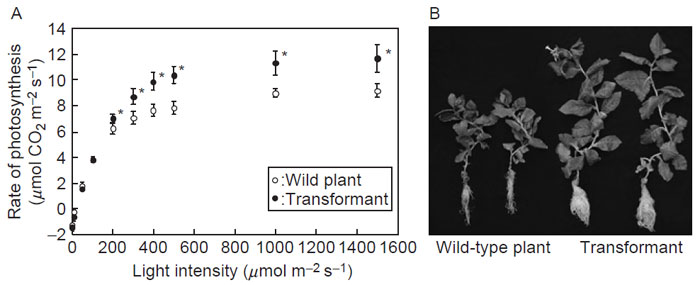RuBP Regeneration
Flux control analysis indicated SBPase as the most likely rate-limiting step for
regeneration of RuBP in the PCR cycle (Robinson and Walker, 1981; see Section
2.2). Furthermore, the two phosphatases FBPase and SBPase, as well as PRK, are
light-regulated enzymes that avoid futile reactions in the dark. Regulation is
exerted through the redox reaction of two SH-groups in these proteins
(Buchanan, 1991). The SH-groups are also targets of hydrogen peroxide under
oxidative stress that affects redox homeostasis (Shikanai
et al., 1998).
In contrast to the plant PCR cycle, cyanobacterial and green algal PCR pathways
are insensitive to oxidation by H
2O
2 and are not subject to light/dark
regulation (Tamoi
et al., 1998). This is because the enzyme involved in the
rate-limiting step of these microorganisms lacks the functional redox-responding
SH-groups (Tamoi
et al., 1996a,b, 2001). While the plant and algal PCR cycles
include FBPase and SBPase as separate entities, both metabolic steps are catalyzed
by a single enzyme, FBP/SBPase, in the PCR cycle of
Synchococcus (Tamoi
et al.,
1996b). The bifunctional enzyme lacks regulatory SH-groups. The gene for the cyanobacterial enzyme fused to a RuBisCO small subunit transit peptide has been
introduced into tobacco (Miyagawa
et al., 2001; Tamoi
et al., 2005). The transformant
created in this experiment revealed improved photosynthetic performance:
transformed plants showed a 2.3-fold increase in chloroplast FBPase and SBP
activities relative to wild type, accompanied by an increase in CO
2-fixation rate
and dry matter to 125% and 150%, respectively, of the wild type (Fig. 4.3). The
photosynthetic rates realized in these transformants may be the maximum attainable
for C
3 photosynthesis because C
3 photosynthesis enters a Pi-limited state at
such high CO
2-fixation rates (see section 2.1).
 |
| FIGURE 4.3 Phenotypes of the wild-type tobacco plant and the transformant expressing cyanobacterial
FBPase/SBPase in chloroplasts. (A) Effect of increasing light irradiance on the net CO2 assimilation at 360 ppm of CO2, 25°C, and 60% relative humidity. The CO2 assimilation rate was
measured using the fourth leaves down from the top of plant, after 12 weeks of culture. (B)
Photographs of the wild plant and the transformant after 18 weeks of culture in 360-ppm CO2 at
400 mmol m-2 s-1. |
With the exception of FBPase and SBPase, there were no detectable changes in
these transformants in either total activities or amounts of enzymes involved
in the PCR cycle. The only changes observed with the transformant were increases
in RuBP levels and in the activation ratio of RuBisCO by a factor of 1.8–1.2 relative
to the wild type (Miyagawa
et al., 2001). These increases in photosynthetic rate are
consistent with an increase in RuBisCO activation. Since RuBisCO activase
requires a relatively high concentration of RuBP as judged from
in vitro assays
(Porits, 1990), the observed increase in activation seems to be due to the presence
of the transgenic FBP/SBPase that appears to function by promoting regeneration
of RuBP and, as a consequence, activating the activase. This study presents the
first example of successful improvement of photosynthetic performance and
productivity by the introduction of a single gene. In addition, it provides proof
for the validity of the concept that single-gene transfers, based on precise knowledge
of metabolic flux, its control, and enzyme activity regulation, can improve
crop productivity. Similar, but smaller, effects have been reported in tobacco
expressing FBPase and SBPase individually (Lefebvre
et al., 2005; Tamoi
et al.,
2006).





